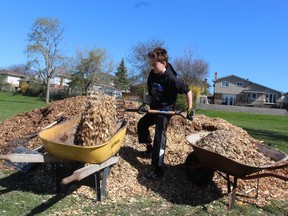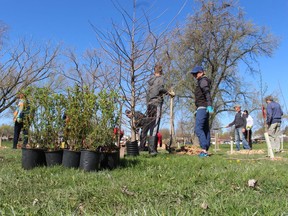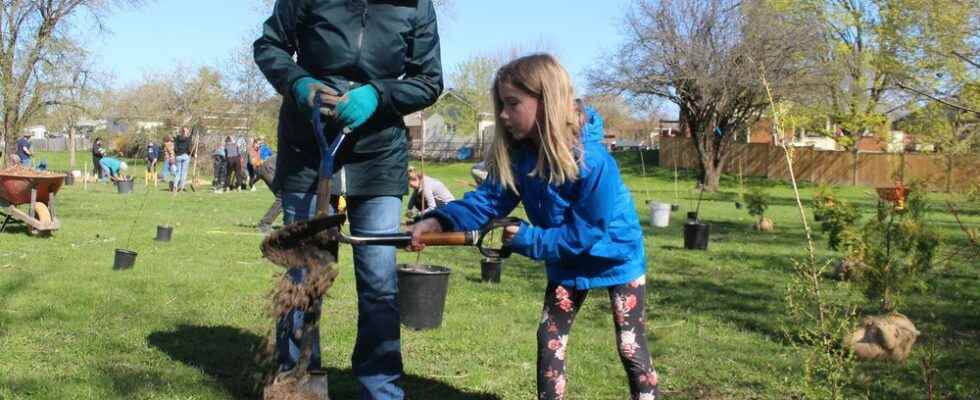A small army of volunteers planted a forest Saturday in a corner of Sarnia’s Wiltshire Park.
It was a project by Climate Action Sarnia-Lambton in partnership with the city and with support from Lambton Wildlife to naturalize a section of the park next to the Howard Watson Trail.
The volunteers arrived with shovels at 9:30 am and Mike Smalls, with Climate Action Sarnia-Lambton, gave instructions for planting about 120 trees and plants that had been set out.
They included tulip trees, red maples, birch, serviceberry, pagoda dogwood, shrub roses and other native species.
“We’re creating a mini forest,” said Smalls, who worked in horticulture for 35 years.

That includes planting items “closer than what you would normally do” with trees and plants to provide an “upper storey” and “mid-storey” as well as a forest floor, Smalls said.
“The concept is they’ll all try to complete against each other, like they do in a forest,” he said.
“Some will grow faster than others. Some might not even be with us in eight or 10 years.”
It will include an area that will be mulched and never cut.
“There’s a lot of items in here for bio-diversity” to attract butterflies, moths and birds, Smalls said.
It an approach that is different from a conventional park with a maintained lawn and some trees scattered here and there.

“Any tree is a good tree, but when you can create a habitat – that’s worth trying to create,” Smalls said.
“Turf provides nothing,” he said. “There’s nothing that lives here. Turf is just overrated. We need to get over this neat and tidy thing. . . there has to be leaf litter.”
The concept for Saturday’s project is something new in the area, and Smalls said they hoped it’s well-received by the neighborhood.
The city said the project in Wiltshire Park is in keeping with Sarnia’s Climate Change Action Plan and Implementation Strategy.
“The thought would be we can carry this forward and do it more often,” Smalls said.
“I’m really anxious to see what this is going to look like in five years,” he said.
Biodiversity is being lost and “we’re losing woodlots at an unsustainable rate,” Smalls said.
“We want to become a bird-friendly community but there’s got to be habitat,” he said. That includes such things as a small forest in a city park providing food and shelter for wildlife.
The Sarnia area is located on an important bird flyway, Smalls said.
The very first Canadian sighting of a marsh sandpiper the previous weekend near Thedford drew hundreds of birders, including some who traveled from across the continent to see it.
“Birding is a huge industry but if there isn’t habitat for the birds, there ain’t no birding,” Smalls said.
Smalls said he wants to show the public the approach used for the project in the park can work.
“People have to get their head around the idea that not everything needs to be neat and tidy,” he said. It’s OK for vegetation to not be “groomed and edged,” Smalls said.
He pointed to the nearby nature trail where vegetation is returning to its natural, and untidy, state.
“We’re just trying to bring a little of that back, in small doses,” Smalls said. “We’re careful here because people are slow to change.”
About 40 volunteers showed up Saturday.
“It’s cool to see people out doing this kind of stuff,” Smalls said.
Wiltshire Park is large enough that it could be a natural “jewel” in the city with trees and pathways, he said.
“We’ll keep working at it.”
On Friday, the group was involved in a similar project at Alexander Mackenzie secondary school in co-operation with the Seaway Kiwanis Club.
“Hopefully it’s going to gain some momentum,” Smalls said.
